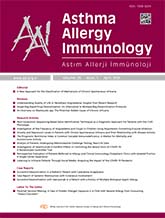


Objective: Common variable immunodeficiency (CVID) is the most prevalent symptomatic immunodeficiency in adults, involving various mutations and clinical presentations. Prognostic markers are not well-defined; however, non-infectious complications, especially autoimmunity, can impact survival and require personalized treatment. This study evaluates the potential of the prognostic nutritional index (PNI)—a marker for disease activity and prognosis in rheumatologic and malignant diseases—to indicate mortality and autoimmune status in CVID patients, along with its associations with demographic characteristics.
Materials and Methods: CVID patients followed at the Immunology Clinic between 2012 and 2024 were included, excluding those with advanced liver failure, active lymphoma, or severe lymphocytosis (>5000/mm³). Age, diagnosis age, follow-up duration, initial immunoglobulin levels, mortality, and non-infectious complications were recorded, along with initial and current PNI values, albumin, and lymphocyte counts.
Results: The 72 patients had a median age of 35.5 years (IQR, 26.5–48.5); 33 were female (45.8%). Twelve patients (16.7%) died during follow-up. Autoimmunity was present in 32 patients (44.4%), splenomegaly in 30 (41.7%), malignancy in 6 (8.3%), and bronchiectasis in 28 (38.9%). Initial PNI value was associated with mortality, with a cutoff of <48.9 determined for mortality prediction, while current PNI values were also associated with mortality. Patients below this threshold had significantly higher mortality rates. Those with autoimmunity showed lower survival rates, along with reduced lymphocyte counts and current PNI levels. Initial PNI was positively correlated with pre-treatment IgG. In univariate survival analysis, older age, lower initial albumin and PNI values, and malignancy were linked to decreased survival.
Conclusion: Given the impracticality of categorizing CVID patients by infection frequency or non-infectious conditions for separate prognostic markers, PNI may serve as an affordable, easily monitored prognostic tool in CVID. Repeated PNI measurements could also provide insights into chronic inflammatory status, particularly in monitoring the development or activity of autoimmune complications.